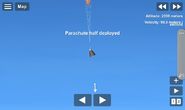Atmospheric entry is the act of entering the atmosphere of a body (e.g. Venus, Earth, Mars, Jupiter in-game). If the rocket is launched from a planet and executes an atmospheric entry on the same planet, the act is called reentry or re-entry. This is explained further down into the article.

Since the re-entry update released on the 10th December 2021, re-entry effects have been present in the game.
Tutorial[]
We need an example rocket for this tutorial. This is also a guide of how to reach space.
Rocket[]
The rocket has only two stages, with a separatable capsule on it. It weighs 232 tons.
First stage[]
The first stage has a Hawk Engine on the bottom, carrying 4 4×8 fuel tanks, all of each weigh 80 tons. There are boosters on each side of the first stage, carrying 3 4×8 fuel tanks, with 60 tons of fuel. At the top are two cones, and at the side that they are attached from the first stage are 2 separators. They are powered by Hawk Engines.
At the top of the fuel tanks is a separator, which separates the first stage from the rest of the rocket.
Second stage[]
The second stage has 2 Kolibri Engines, clipped together. It carries a 4×6 fuel tank (15 tons), and has an astronaut capsule with a parachute. The second stage has a separator to separate the capsule from the second stage.
Continuation[]
If the rocket is ready, it is now ready for launch!
Tutorial[]
- Launch the rocket; turn slowly.
- Separate the boosters simultaneously when they burn out.
- Get into orbit using only the engine on the first stage.
- Separate the first stage.
- Wait until the rocket reaches the apogee, then turn retrograde (if you are in a circular orbit, you can do this at any time).
- Execute a small burn until the perigee is at 15 – 10 kilometers.
- Separate the capsule from the second stage.
- When the capsule enters the atmosphere, turn the capsule's heat shield to the direction of travel.
- When the capsule enters the upper atmosphere, it would heat up into around 3400 degrees Celsius, depending on velocity (the faster the capsule goes, the hotter it gets). Burn marks would appear on the heat shield, and the bottom of the capsule itself. The reentry flame will get more intense as it slows down, and it would become less intense as it drops into the lower atmosphere.
- When the capsule drops below 10 kilometers, you should see the velocity dropping faster as the rocket approaches the ground.
- When the speed is below 250 m/s and below 2500 meters, deploy the parachute. The capsule will slow down significantly.
- Separate the heat shield when the capsule drops to 200 meters.
Reentry[]
Reentry (also called re-entry) is an act of entering an atmosphere but Earth (or the place where the rocket is launched) is only involved.

An example of reentry on Earth.
Atmospheric entry on celestial bodies[]
The Sun, Venus, Earth, Mars and Jupiter can experience a rocket burning up into their atmospheres. They are further listed down here:
Sun[]
The sun has a high gravitational acceleration (274 m/s²), therefore getting to (and maintaining) a speed where reentry would be possible is very difficult. In real life, it is not portrayed like that; instead, the rocket will become gas particles (and some ashes) because of the high temperature. The gas particles would then get thrown off by a solar flare, or become part of the sun. There was a satellite that managed to get extremely close to the Sun without turning to gas nor becoming part of the Sun. It's name was the Parker Solar Probe.

A rocket burning up in the Sun's atmosphere. In real life, a rocket passing close to the sun would melt instead of burning up.
Venus[]
The effect is strong. Rockets that travel fast (like when it comes from Earth) would get a high temperature and disintegrate.
Due to Venus's high temperature, stacks of heat shields must be used to protect a rocket from burning up in the atmosphere too quickly.
Earth[]
The effect is weaker than Venus, but rockets that travel fast will still burn up in the atmosphere very quickly.
If the rocket came from orbit, Moon, Venus, or Mars, the rocket will enter Earth at a high temperature, thus surviving the heat of reentry. If reentry is fast (like the rocket came from Mercury or Jupiter) the rocket would break up quickly, even if it has a protective heat shield.
Mars[]
The effect of a rocket descending on the Martian atmosphere is weak, due to the thinness of the atmosphere, but don't underestimate its effects since it always reaches temperatures above 1500 degrees Celsius due to how much time it takes to slow down enough. Try slowing down first to a slow speed before landing to avoid the effects of the Martian atmosphere.
Jupiter[]
The effect is very strong, since the atmosphere is thick. Rockets entering the atmosphere would burn up extremely quickly, even with a heat shield, due to the entry speed and atmospheric density.
Gallery[]
Trivia[]
- The reentry effect is almost similar to the reentry effect from Kerbal Space Program but stronger.














